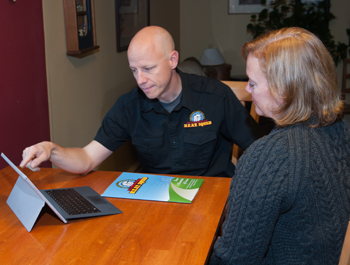Image

Ludy Biddle, Executive Director, NeighborWorks of Western Vermont
Challenge: Many older homes in Western Vermont are owned by residents with low to moderate incomes and are poorly insulated and lack energy-efficient appliances. Despite their high utility costs, these homeowners either don't see the value of retrofitting their houses with energy modifications – or they simply can't afford to.
In Western Vermont, many older homes are owned by residents with low to moderate incomes and are hit with high utility bills due to poor insulation and the lack of energy-efficient appliances. Yet homeowners either don't see the value of retrofitting their houses with energy modifications or they don't have the necessary funds. NeighborWorks of Western Vermont recognized the problem and set an ambitious goal to retrofit 1,000 homes in Rutland County within three years, cutting household energy needs by a minimum of 15 percent, saving $1 million and sharply reducing carbon emissions.
Energy efficiency investments provide tremendous savings for homeowners and create meaningful local jobs. As a nonprofit HomeOwnership Center, NeighborWorks of Western Vermont recognizes this and has always recommended weatherization.
However, despite a robust state financial incentive program for efficiency upgrades — Home Performance with Energy Star — and a pool of certified contractors, the number of retrofits completed prior to 2010 in Rutland County was a paltry 26. At the time, the county represented 10 percent of the state's population, but only five percent of the state's retrofit market.
In 2010, NWWVT received an unprecedented grant from the Department of Energy to create HEAT Squad, a program to help facilitate further energy efficiency upgrades in Rutland County. Our intention was to use our own expertise to leverage the state's incentive program to increase demand for energy efficiency upgrades.
In our application for the grant, we argued for a one-stop shop that delivered a low-cost energy audit, recommendations about efficiency improvements, and affordable finance options for installation.
Rather than extravagant incentives for client upgrades, we decided to offer a new model of high-level customer service. To that end, it was essential to get homeowners to run an energy audit — a comprehensive evaluation of a home's energy efficiency. Thus, outreach became a cornerstone of the program.
 We established early on that word-of-mouth was our single greatest source of client referrals, and so made it our business to take part in community events such as educational programs, competitions, celebrations, and local forums. This helped stimulate word-of-mouth exchanges and got more people to call and inquire about our services.
We established early on that word-of-mouth was our single greatest source of client referrals, and so made it our business to take part in community events such as educational programs, competitions, celebrations, and local forums. This helped stimulate word-of-mouth exchanges and got more people to call and inquire about our services.The next step was to set a price for home efficiency audits. We learned a lot by using different price points: A homeowner who booked a free audit, generally had no intention of making upgrades, while a homeowner who booked a $50 audit, generally wanted to confirm that their home was already pretty efficient. But, when we priced audits at the market rate of $350, calls stopped. We eventually discovered that $100 was the "sweet spot" for audits. Homeowners found the price affordable, yet felt sufficiently invested to take our recommendations seriously.
Local independent contractors were the next link in the chain. They were critical partners, but presented challenges. For one, doubling the demand for energy upgrades meant a sudden need for more home-efficiency certified contractors. To help, NWWVT offered free building training and certification, heat pump installation training, business training and more. Through these initiatives, HEAT Squad helped create at least 62 jobs as well as three auditing and contracting businesses.
Another problem was that many contractors lacked the information and customer service skills needed to promote energy-saving projects. So, we facilitated the Dale Carnegie Weatherization Sales Training Course, and made it mandatory for all contractors in the program. We also established firm timelines for contractors to submit energy audit reports and to contact customers. These requirements netted a marked increase in conversion rates from energy audit to retrofit project.
To help with capacity, we created a temporary labor pool to resolve seasonal workload bottlenecks, and made four equipment loans totaling $139, 589. With funding from the Vermont state treasurer, NWWVT also allocated $2 million for energy loans at competitive rates for homeowners.
By the end of 2014, HEAT Squad had completed 1,200 Home Performance with Energy Star retrofits, 1,000 of which were within Rutland County. To date, we have accomplished 1,400 retrofits in an expanded five-county territory, providing homeowners a 32 percent average reduction in energy costs saving the participating residents more than $1 million dollars a year in energy costs. And we finally managed to reach the low- and moderate-income households we set out to help at the beginning of the project. These households are 267 times more likely to install efficiency measures with the help of HEAT Squad than with state incentives alone, according to a study by the independent Cadmus Group. Our very role as a Homeownership Center accustomed to educating and advising has been our greatest asset.
"Ever since I've been here, the house always felt damp and cold. I realized I have to watch my pennies. The improvements are a valuable way to not freeze anymore. It's wonderful," says Angela Combes, a Rutland Town resident.

